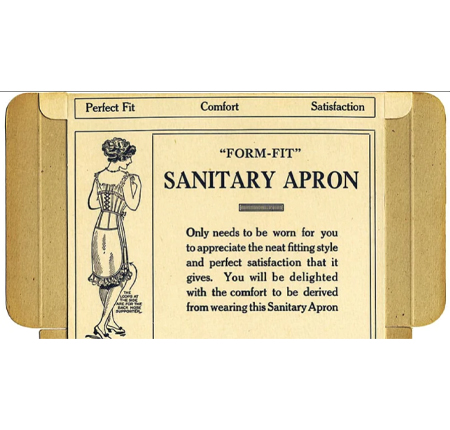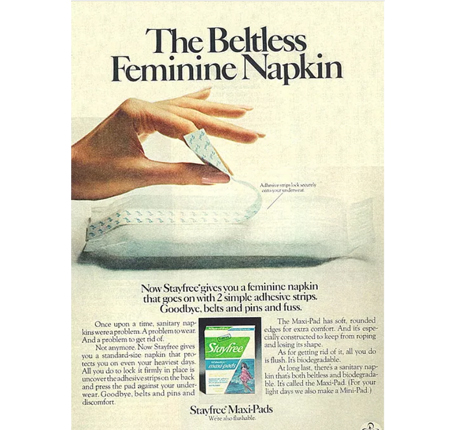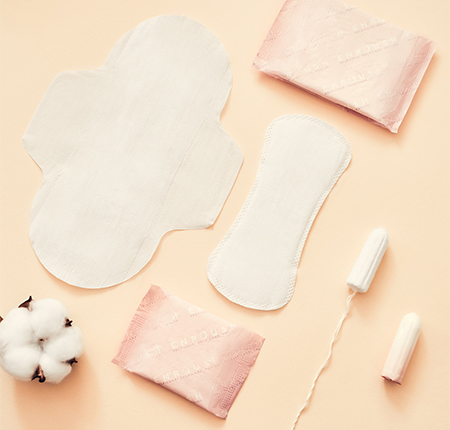
Menstruation has always been a taboo subject, especially when the industry was in full swing, but prejudices about menstrual "hygiene" continue to haunt our society even today.
Did you know that until 1985 the word "menstruation" was not mentioned on TV?
It is only after almost 100 years since the first tampons appeared on the market that innovation is making its way and we have more and more sustainable and safe options for personal health and the planet. But how did it all begin?
When did the first absorbent pads appear?
Before disposable pads were invented there were several mentions of "pad ancestors" throughout history. And the first reference appears somewhere in 10th century Greece: cotton or woolen cloths, rabbit fur, grass bundles - these were just some of the options that menstruating people used when needed.
In the 1800s both in Europe and the United States of America most "menstrual cloths" were made at home, from various fabrics - hence the American euphemism "on the rag" (rag meaning cloth) appeared in the 19th century to describe one person per cycle.

Sanitary breeches in the 1850s
At the beginning of the 20th century , there was concern about women's intimate hygiene, the inadequate cleaning of menstrual cloths affecting their health.
Meanwhile, various products are being patented: the first menstrual cups (made of aluminum or hard rubber!), rubber-lined underwear and many others.
But the first disposable pads were created by nurses on the battlefield to stop excessive bleeding during the First World War.
Nurses notice that cellulose has a greater absorption power than cloth bandages, and they begin to use the material for menstruation as well, and in 1921 the first Kotex sanitary napkins made of "cellucotton" - this hyper-absorbent vegetable material - are sold.
The advent of sanitary napkins in the 1920s allowed women to have more control over their own bodies and more independence, giving them access to work and participation in activities outside the home to a greater extent than before - an important step for emancipation.
As for people with an active life - dancers, athletes - the market of menstrual products is expanding with a new product that meets the demand for more flexibility: this is how tampons appeared in the 1930s. But it is curious that although the first tampons were not super -different from those found on the market today, they were more sustainable: cardboard applicator and cotton pad, with cotton thread.
However, tampons remained unpopular until the 1980s. In the meantime, sanitary napkins enjoyed two major improvements: the first, major one, in 1969 when the StayFree brand launched the adhesive tape sanitary napkins, and the second in the 1980s when they added fins. 
In 1969, Stayfree launched the first absorbent pads without a belt, with adhesive tape!
Tampons gain popularity, but health problems intervene: more than 5,000 cases of toxic shock syndrome (TSS) were reported between 1979 and 1996, many of which were linked to a particular brand of tampon and the toxic materials used.
The 2000s bring new sustainable products to the market - along with tampons and organic absorbents: reusable absorbent pads, menstrual panties and menstrual cups, but also a series of new, stricter regulations.
What do we use today for menstruation?
Demand for menstrual products has grown, and so have concerns about sustainability. There are approximately 2 billion menstruating girls and women today, and it's no surprise that menstrual waste has increased significantly. The UK alone generates 200,000 tonnes of menstrual waste each year! And a large part of these ends up polluting the oceans. How Polluting Is Your Period? Read here
Conventional menstrual products - have seen little innovation in recent years and are still made with up to 90% plastic, synthetic fibers and toxic substances. Furthermore, "classic" brands of menstrual products are not transparent, so you most likely won't find an ingredient list on your menstrual care package.
And because your vulva & vagina are extremely absorbent, in direct contact with these products, your body absorbs all the harmful ingredients, leading to less pleasant side effects, such as:
- Hormonal imbalances
- Thyroid diseases
- Irritations and allergies
- Various infections
- Heavy menstrual bleeding
- Endometriosis
- Diabetes
Organic menstrual products - biodegradable / sustainable / reusable - are the responsible choice for both your body and nature.

Especially organic products that, being made only of 100% organic cotton, without chemicals or plastic, have no side effects on your body. Of course, in the case of tampons, you must respect the rule of changing them every 4 hours - as in the case of "regular" ones. In addition, being biodegradable or compostable, they disintegrate in 12 months. That means 0 pollution.
Only in recent years has awareness of environmental issues related to menstrual products resulted in positive action, and luckily, sustainable options exist: they're just a click away.






















